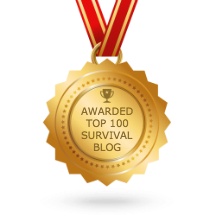WATER IS LIFE
I don't need to tell you why your family
needs safe potable water as well as long term food storage, first aid
kits, and other survival gear to survive the aftermath of an emergency
or disaster.

People can live for days or even weeks without food
but no one survives past 4 or 5 days without water. Living on very short
rations an "average" person can survive on a minimum of one gallon of
water for replacement of normal activities loss, per day. At that
drastically minimal rate a family of four will need 120 gallons of
potable water to survive for 30 days.
"...Drinking, sanitation
and hygiene constitute the basic human survival needs for water. These
minimum needs total about 50 liters (13.2 gallons) per person per day.
In comparison, the average American uses well over ten times that
amount...(1)"
Including drinking, sanitation and hygiene that
same family of four would need 1560 gallons of potable water to survive
for 30 days. Storing 120 gallons of water to meet subsistence-level
needs is easily done, if that's how you visualize your family surviving.
Storing 1560 gallons, while making your family's survival experience
more pleasant, is problematic if you do not have the ability to
replenish your water supply while off of the National Electric Power
Grid.
WATER AVAILABILITY IS NOT GUARANTEED
What if one day
after an emergency or disaster you turn on the tap and either nothing
comes out, or what comes out is unsafe to drink? Water distribution
systems require energy and what comes out of your faucet is there
because the fragile and vulnerable Grid energized a pump.
The
National Electric Power Grid is obsolescent and vulnerable to blackouts
due to equipment failure, unintentional human error or recently and most
frighteningly, malicious foreign cyber attack.(2) Water
self-sufficiency off the grid, and independent of the weather, will
ensure that your family has enough water to survive no matter how bad
the situation becomes.
RAIN WATER HARVESTING
The basic
component of water self-sufficiency is rain water harvesting and
storage. This component requires storage tanks of sufficient capacity
with connections to your home's rain gutter system. This component is
weather dependent but based upon annual rainfall amounts and seasonal
rains distribution in your area, rain water harvesting may well satisfy
your un-purified water requirements if you plan properly.
In most
parts of continental USA, with the exception of the Southwest, rainfall
is fairly regular, reliable and predictably sufficient to be the primary
source for your family's survival water self sufficiency. You will have
to make a judgment call and decide how much storage capacity you will
need to bridge dry spells.
Because we have become so dependent on
the grid and the water distribution systems it enables, houses no longer
have cisterns to store water for dry spells. Chances are your home
doesn't have a cistern either, so you will need to acquire water storage
capacity. Water can be stored in almost anything: one gallon water jugs
you buy at the supermarket, hard-side metal or plastic tanks, or the
much more convenient and less expensive collapsible "pillow" tanks.
We
can safely discard the idea of buying, storing and then refilling 1500+
one gallon jugs as impractical. Hard-side tanks are more practical but
are always the same size, full or empty, are difficult to handle,
expensive and require permanent installation above ground or below.
A
much better solution
is collapsible "bladder" tanks which are constructed of polymer alloy
coated polyester fabrics which meet FDA standards for potable water
storage. Bladder tanks are relatively inexpensive and can be stored
folded within their shipping boxes until you decide to deploy them.
PURIFYING STORED RAINWATER
The
water stored in your tanks, while it may appear clear, is not safe to
drink. The rain which fell on your roof and ran down your gutters became
contaminated with bird feces, insect waste, decayed organic matter,
chemicals and other pollutants. To make this water safe to drink it must
first be treated or preferably purified.
Treatment involves
adding proportionately large amounts of chlorine iodine. This method
should be reserved for emergency or occasional use only, because
ingestion of too much iodine may be harmful.(3)
The optimum
solution is a water purifier which removes sediment and chemicals, kills
pathogens and removes pathogenic detritus. An efficient water purifier
would use both pre and post-filters and a high-intensity ultraviolet
germicidal lamp. Such a device must be proven to have a bacterial kill
rate up to 99.99+% including cysts (Giardia and Cryptosporidium), and
microorganisms including viruses, bacteria, fungi, algae, and
protozoa.(4)
This water purifier should be operable off the
Electric Power Grid and capable of converting water from any available
source into potable water.
NOW YOU NEED TO BECOME WATER SELF SUFFICIENT
You
have acquired long term bulk food storage, first aid kits, tools,
defensive weapons and other survival gear. Now you need to become water
self-sufficient or all your other preparations are meaningless and your
family will perish. WATER IS LIFE.
(1) Basic survival needs were
stressed at the Mar del Plata conference, a major international effort
to address world water problems organized by the United Nations... The
minimum water requirement for replacement for an "average" person has
been estimated to be approximately 3 liters (3.2 quarts) per day, given
average temperate climate conditions...
(2) The Washington Post, "Checkpoint Washington" Blog, 11/18/2011
Read more:
http://www.washingtonpost.com/blogs/checkpoint-washington/post/foreign-hackers-broke-into-illinois-water-plant-control-system-industry-expert-says/2011/11/18/gIQAgmTZYN_blog.html
(3) Heath Canada. Read more:
http://www.hc-sc.gc.ca/ewh-semt/pubs/water-eau/disinfect-desinfection-eng.php
(4)
University of Arizona, Department of Soil, Water and Environmental
Science, Tucson, AZ Copy of report available upon request.
For complete survival preparedness planning, and to purchase the
best survival gear: long term bulk food storage and mobility survival
kits, SURVIVAL H2O Tanks™, the SURVIVAL H2O Partner™ and the SURVIVAL
STOVE™, tools, light and communication gear, non-firearm weapons and
supplies as well as plans, strategies and tactics visit:
http://www.mybestsurvivalproducts.com





